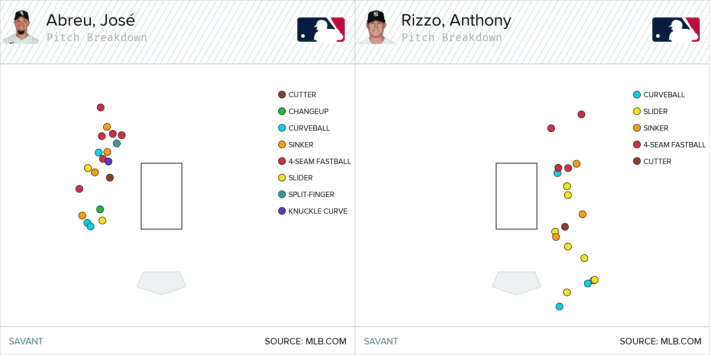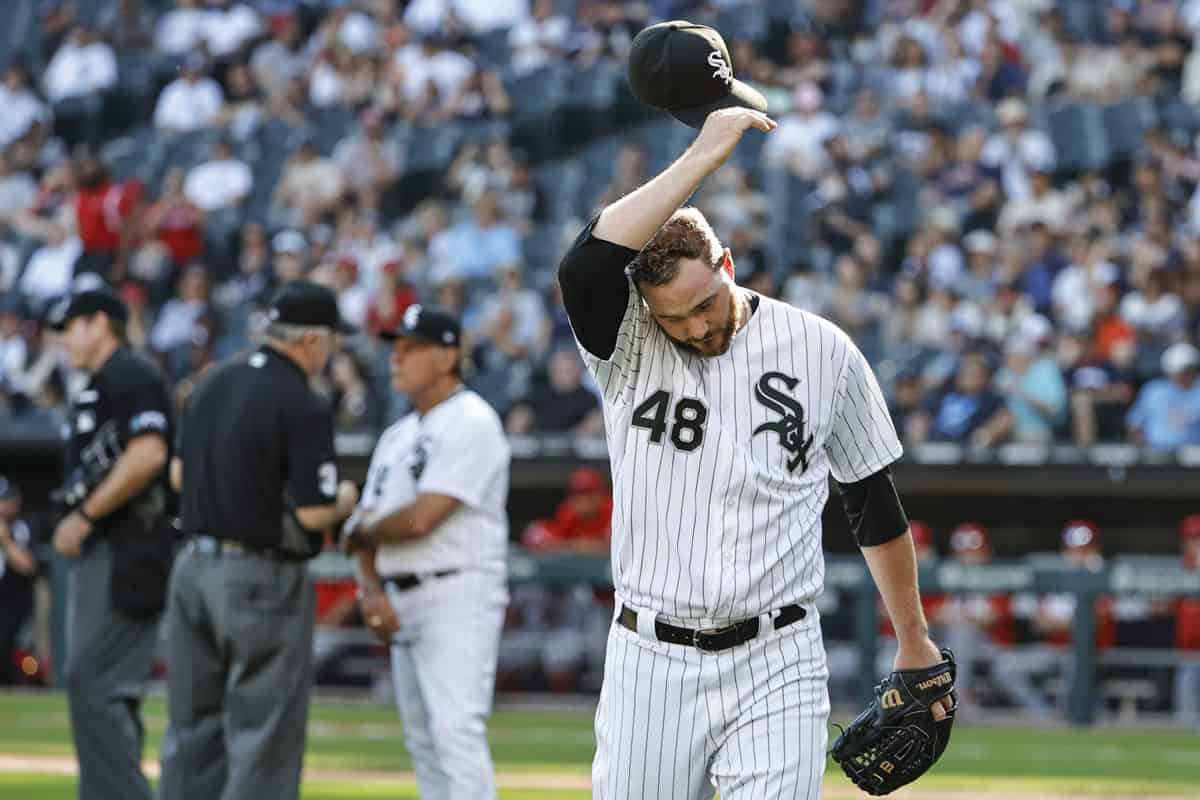Tony La Russa wasn't in the dugout for the White Sox's 2-1 loss to the Rangers in Arlington on Saturday, as he was serving an automatic one-game suspension accompanying Mike Wright's ejection for a suspected retaliatory pitch on Thursday.
The league threw the book at Wright, relatively speaking, by handing him a three-game suspension. Wright appealed, and given that there are only two weeks left in the season, he might be able to run out the clock.
La Russa wasn't happy about the ruling, as one might expect.
“Once that happens, this is all automatic. I just don’t think that there’s been enough information that’s really been distributed,” La Russa said. “We’ve hit fewer batters than any team in Major League Baseball. And most importantly, if you watched how we pitched Ohtani for three days, we avoided the middle of the plate.
“In, away, up, down, we avoided the middle. That’s the way we pitched to him. Finally, I didn’t see the scrutiny being even. It was that one pitch, we had plenty of opportunities to be upset, and we were just pitching him the same way we pitched him the whole time. But our guys, three guys get hit, one guy gets hit in the head, Abreu gets hit for the 19th time, and nobody pays attention to that. There’s an unfairness there that upsets me.” [...]
As La Russa pointed out, his team ranks last in the Majors in opposing batters hit with just 47. He believes the whole scenario presented Thursday and Saturday could help Wright in his appeal process to MLB.
The problem is that it wasn't "that one pitch." It was two pitches, and potentially three, all coming after a well-located fastball at the top of the zone and just off the plate for a fouled strike one.

The second pitch was a fastball that almost took out Ohtani's legs. The third pitch was a changeup, but it missed wildly inside relative to where Zack Collins had set up. Then came the "one pitch" in question, which struck Ohtani on the calf. When Wright got booted from the game, it didn't strike me as unreasonable, because it looked like he was using Ohtani for target practice.
* * * * * * * * *
Now, was he? It's possible, what with Abreu, Yoán Moncada and Luis Robert all getting plunked on Tuesday, and Robert's a beanball. Ohtani is the Angels' best player, there were two outs and nobody on in a blowout loss. That's typically the time to do it, at least when assessing the combination of leverage and star magnitude.
But two days after the incident, with a Dallas Keuchel HBP of Jack Mayfield the only plunking that happened in between for either team, makes it too late to have any kind of useful connection to the three Sox nailed on Tuesday.
That's one defense of Wright. The other is that he wouldn't breach baseball protocol by throwing at a guy in a middle of an at-bat. That's seen as a cowardly form of retaliation, the equivalent of a sucker punch after a hitter has let down his guard. It was most notably discussed in an exchange of HBPs issued to Arizona's Paul Goldschmidt and Pittsburgh's Andrew McCutchen in 2014. To sum it up quickly, Goldschmidt was lost to the season due to a pitch that hit his hand, so the next day, Arizona's Randall Delgado drilled McCutchen in the back with a fastball in the bottom of the ninth ... on a 2-0 pitch.
McCutchen was mad because he expected to be plunked, and Delgado missed inside with his first pitch. But then Delgado went slider away before coming back with the fastball to the back, and McCutchen didn't appreciate Delgado's pretending to work both sides of the plate.
"They had all game to retaliate," he said. "They had the first inning to retaliate, they had that first pitch to retaliate, missed. You throw a slider the second pitch, and then you throw up and in on the next pitch. Are you trying to hurt me too? That's the question."
The biggest problem with this explanation is the poor reflection of Wright's competency. He missed very, very badly on three consecutive pitches to the other team's best player in a situation that sends a message while not affecting the game. "My control utterly collapsed" might've been the real reason, but it isn't flattering.
The other is that the Arizona Diamondbacks' Chief Baseball Officer at the time of the Goldschmidt-McCutchen War of 2014 was none other than Tony La Russa, who issued similar-sounding defenses of his organization.
"When you pitch in, you still always try to pitch down, because this is such a dangerous area," he said. "That, to me, is what's surprising and upsetting about how shortsighted this criticism is. Here's a team that's lost three hitters — (Aaron) Hill, (A.J.) Pollock and Goldschmidt — with broken bones (since the start of last season). Those pitches should never be thrown up there, never." [...]
Holding a stat sheet, La Russa pointed out the Pirates have hit 61 batters, the most in the league, while the Diamondbacks have hit just 32. La Russa also downplayed Towers' comments from the offseason, saying the GM was just saying his team needed to pitch inside more often.
"That's why I think it's unfair," he said. "I think it will continue to be unfair because I don't think this message will get out."
Earlier that season, then-Diamondbacks reliever Evan Marshall got a congratulatory fist bump from manager Kirk Gibson for a "successful" retaliation in which Marshall threw behind Ryan Braun before hitting him in the backside, earning a warning and an ejection on consecutive pitches. "Successful" is in quotes because the Brewers then hit a grand slam to take the lead.
This isn't to say that La Russa ordered this one, because the White Sox have let plenty of HBPs slide. It's just that he isn't the most reliable narrator in these cases. As concerned as he is about the HBP disparity, La Russa invited one to Yermín Mercedes, and defended Trevor Duffey afterward for his attempt...
“What did they do? The guy might have just been trying to get a sinker in. We don’t read minds. I’m not going to read their mind, and I’m not going to second guess the umpire when it’s his judgement. The ball was thrown at somebody’s head, and then you don’t give anybody the benefit of the doubt.”
... in a way that sounded similar to his defense of his own player back in 2014.
"Who's got a mind reader?" said La Russa, the Diamondbacks' Chief Baseball Officer. "I don't know that Delgado — he got the ball inside. I'm very careful when I say I know. If I don't know, I don't know."
Just like Wright, Duffey was suspended for three games and Rocco Baldelli one, even though there weren't any warnings, and even though La Russa didn't detect intent. Duffey appealed the suspension and got it reduced by a game. Wright can probably do the same. That's generally how it works, especially with umpires tasked with keeping butts on benches during the pandemic (Adam Eaton served a one-game suspension for light shoving at second base earlier this year).
* * * * * * * * *
Counterproductively and ironically, this kind of reaction from the league office only encourages the White Sox to be more proactive with their defenses of their hitters, particularly Abreu. He's been drilled a whopping 19 times, and not because he crowds the plate. Here's a look at the pitches that have connected with Abreu, compared to a true plate-crowder like Anthony Rizzo.
Both of them have drawn 19 HBPs this year, but Abreu's are concentrated in one area. He gets hit a lot by pitchers who can't pitch inside.

White Sox pitchers should probably throw at more guys, especially in a game where Abreu gets plunked early. The purpose behind a purpose pitch shouldn't be bloodlust, but the triggering of warnings that make future wayward fastballs ejectionable offenses. If the White Sox are so much better at avoiding HBPs than other teams, they could leverage that strength by using the legal system to eliminate the right to miss badly inside. It has the crude markings of Hammurabi's Code, but it's less "eye for an eye" and more "don't rely on the police to avoid a blinding." Throwing behind a hitter's legs accomplishes the same purpose without the injury risk/free base, although it might be harder to maintain the plausible deniability that's important for remaining in the game in 2021.
Whatever the case, it has to be more decisive than what Wright showed, assuming Wright had ill intent. If Wright wasn't trying, he probably shouldn't miss on three consecutive pitches that badly. That kind of display ruins it for everybody else.
(Photo by Kamil Krzaczynski/USA TODAY Sports)





